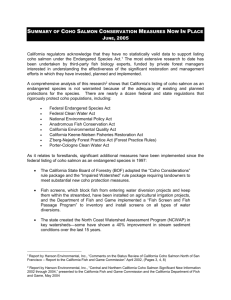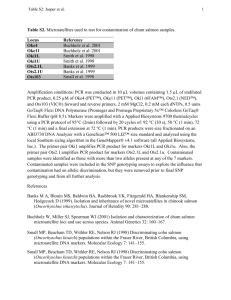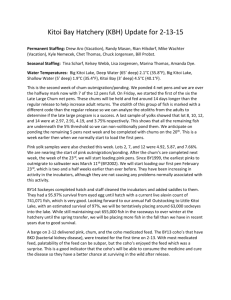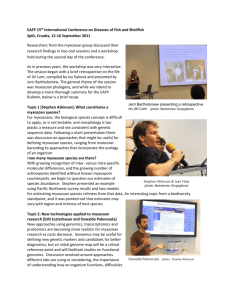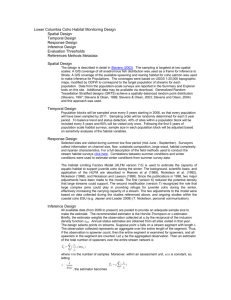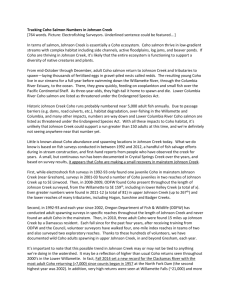Habitat Requirements for Coastal Coho Salmon Populations
advertisement
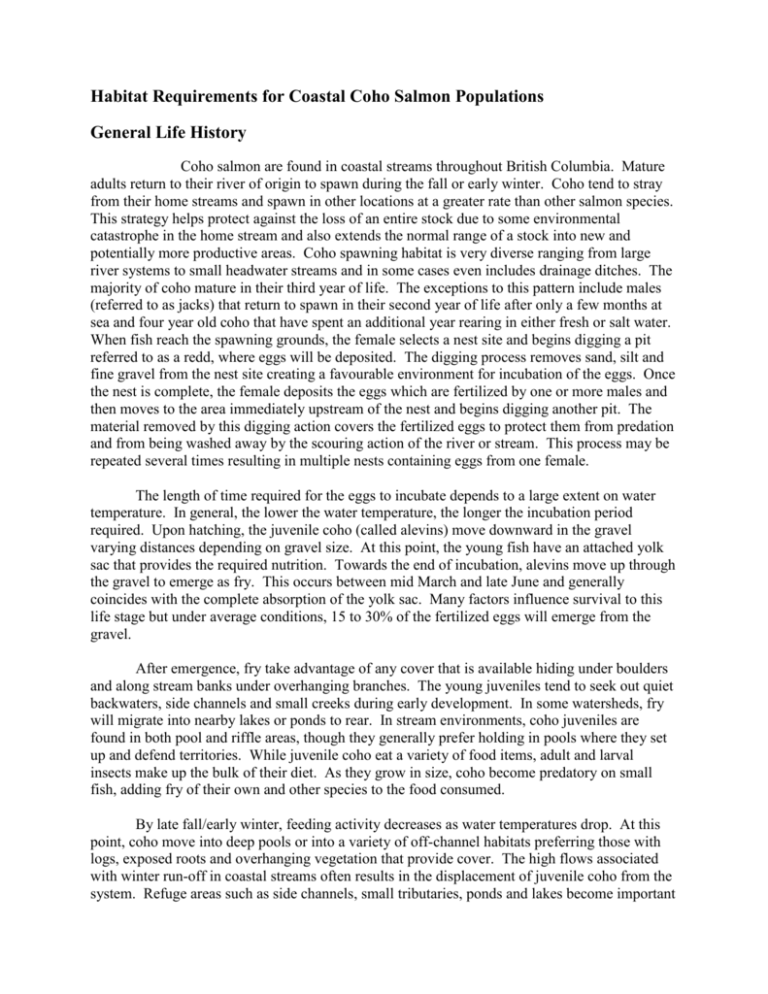
Habitat Requirements for Coastal Coho Salmon Populations General Life History Coho salmon are found in coastal streams throughout British Columbia. Mature adults return to their river of origin to spawn during the fall or early winter. Coho tend to stray from their home streams and spawn in other locations at a greater rate than other salmon species. This strategy helps protect against the loss of an entire stock due to some environmental catastrophe in the home stream and also extends the normal range of a stock into new and potentially more productive areas. Coho spawning habitat is very diverse ranging from large river systems to small headwater streams and in some cases even includes drainage ditches. The majority of coho mature in their third year of life. The exceptions to this pattern include males (referred to as jacks) that return to spawn in their second year of life after only a few months at sea and four year old coho that have spent an additional year rearing in either fresh or salt water. When fish reach the spawning grounds, the female selects a nest site and begins digging a pit referred to as a redd, where eggs will be deposited. The digging process removes sand, silt and fine gravel from the nest site creating a favourable environment for incubation of the eggs. Once the nest is complete, the female deposits the eggs which are fertilized by one or more males and then moves to the area immediately upstream of the nest and begins digging another pit. The material removed by this digging action covers the fertilized eggs to protect them from predation and from being washed away by the scouring action of the river or stream. This process may be repeated several times resulting in multiple nests containing eggs from one female. The length of time required for the eggs to incubate depends to a large extent on water temperature. In general, the lower the water temperature, the longer the incubation period required. Upon hatching, the juvenile coho (called alevins) move downward in the gravel varying distances depending on gravel size. At this point, the young fish have an attached yolk sac that provides the required nutrition. Towards the end of incubation, alevins move up through the gravel to emerge as fry. This occurs between mid March and late June and generally coincides with the complete absorption of the yolk sac. Many factors influence survival to this life stage but under average conditions, 15 to 30% of the fertilized eggs will emerge from the gravel. After emergence, fry take advantage of any cover that is available hiding under boulders and along stream banks under overhanging branches. The young juveniles tend to seek out quiet backwaters, side channels and small creeks during early development. In some watersheds, fry will migrate into nearby lakes or ponds to rear. In stream environments, coho juveniles are found in both pool and riffle areas, though they generally prefer holding in pools where they set up and defend territories. While juvenile coho eat a variety of food items, adult and larval insects make up the bulk of their diet. As they grow in size, coho become predatory on small fish, adding fry of their own and other species to the food consumed. By late fall/early winter, feeding activity decreases as water temperatures drop. At this point, coho move into deep pools or into a variety of off-channel habitats preferring those with logs, exposed roots and overhanging vegetation that provide cover. The high flows associated with winter run-off in coastal streams often results in the displacement of juvenile coho from the system. Refuge areas such as side channels, small tributaries, ponds and lakes become important for survival as they provide shelter from flood events. The productivity of many coastal systems depends on the availability of good winter refuge habitat and those with abundant off-channel refuge areas lose fewer fish during extreme winter flood events. The migration of juvenile coho downstream to the sea begins in the spring and continues over a period of three to four months. In most southern British Columbia coastal systems, this migration peaks in May. The coho at this stage of their life are referred to as smolts and generally measure between 90 and 115 mm in length. In the majority of southern coastal systems where water temperature and food availability are favourable, coho become smolts after spending only one year rearing in fresh water. In some less productive northern coastal systems, many coho juveniles spend two years in fresh water before smolting. During migration to the estuary, coho smolts are vulnerable to a wide range of predators that include larger fish, birds and marine mammals. In some cases, this predation can have a large impact on survival. When they first enter salt water, coho smolts primarily feed on marine invertebrates, but as they grow larger, smaller fish begin to dominate their diet. Growth during the marine phase is rapid due to the abundance of high quality food items. For the majority of coastal coho salmon, sexual maturation occurs during their second summer at sea when the journey back to the river of origin begins. Most mature adult coho finish their ocean rearing phase after about 16 months at sea when they are three years old. Habitat Requirements by Life History Stage The decline in abundance of coastal coho salmon populations over recent years is due in large part to reduced marine survival. However, major concerns have also been raised over the loss and degradation of fresh water habitat due to increasing economic and developmental pressures. The loss of habitat is associated with the increase in the number of people living near coho rearing streams and also with the increased intensity of resource use. Low-gradient streams within 100 km of the coast make up a significant proportion of the fresh water habitat for coastal coho salmon populations in British Columbia. These are also the most desirable areas for human settlement and economic development activities. Consequently, coho habitat remains threatened throughout Pacific coastal regions. This is especially true of small streams and off channel areas which have often not been properly protected from development. Spawning Adult salmon require unimpeded access to their home spawning grounds in order to successfully reproduce. Features such as dams, debris jams, waterfalls, or rock/mud slides that block upstream migration can limit access to spawning areas and impact production. Also, if conditions such as high water temperature or extreme high or low flows are encountered when spawners arrive at their river or stream of origin, fish often mill about in the vicinity of the river mouth, waiting for conditions to improve. This delay in river entry can have a detrimental affect on survival and on spawning success as fish are exposed to predation from marine mammals and, since feeding has stopped in preparation for spawning, vital energy reserves are used up. As a result, it is important to critically assess any activities that impact river flows or water temperatures when mature coho are returning to spawn and to ensure that fish have unimpeded access to spawning grounds. Spawning coho salmon require gravel that is small enough to be moved by the fish and large enough to allow good intragravel water flow to the incubating eggs and developing alevins. This ensures that the environment in the nest is supplied with a constant flow of water that delivers oxygen and removes waste. A lack of clean spawning gravel of the appropriate size can limit coho production in some systems as spawners may be forced to build redds in secondary locations where egg survival will be reduced. Incubation During incubation, eggs and alevins require a stable environment with an uninterrupted supply of clean, oxygen rich water. The percentage of eggs and alevins that survive the incubation phase depends to a large extent on stream and stream bed conditions. Flooding during winter months can result in a large amount of gravel movement which reduces survival by causing eggs or alevins to be exposed and swept downstream. Also, silt loads associated with flooding may hinder water circulation through the redd reducing available oxygen to harmful or lethal levels. Studies have shown that a higher proportion of fine sediment in the spawning gravel reduces survival and results in smaller emergent fry. Activities that contribute to flooding or siltation of incubation areas can magnify the impact of extreme winter conditions and reduce survival to emergence. Juvenile Rearing Stream Habitat: Due to an extended fresh water rearing phase, coho salmon populations are often limited by the amount of quality freshwater rearing habitat available. Juvenile coho salmon require a variety of habitats during each season of their fresh water rearing phase. During the summer, the stream’s carrying capacity may be constrained due to low flows which limit the quantity of pool habitat and therefore, the number of suitable territories that are available. In addition, low summer flows can reduce the overall wetted area available to coho and strand juveniles in isolated pools. This results in increased vulnerability to starvation, disease and predation. High summer water temperatures can affect juvenile coho distribution, abundance and survival in coastal streams. While it may be rare for water temperatures to reach lethal levels, sub lethal water temperatures can negatively impact juvenile coho by increasing metabolism, lowering the amount of dissolved oxygen available in the water, and by forcing coho out of preferred habitat. During the winter, juvenile coho salmon require habitats with low water velocities such as side channels, back waters, beaver ponds, deep river pools, and pools formed by large woody debris and root wads. Research indicates that in many coastal systems, it is the amount of suitable winter habitat that limits coho production. These habitats provide protection from high discharge as well as protective cover from predators and there is often a strong relationship between smolt abundance and the amount of off-channel habitat available in a system. Streamside (riparian) vegetation plays an important role in regulating the temperature in coho rearing streams. Cooler winter water temperatures may occur if the stream canopy is absent or reduced while warmer summer temperatures may make the habitat unsuitable or may increase the mortality of fry from disease. Also, streamside vegetation acts as a habitat for terrestrial insects and a source of leaf litter utilized by stream invertebrates. Both of these factors act to increase the food available to juvenile coho rearing in streams. Finally, riparian vegetation provides cover from predators and stabilizes stream banks, which reduces the amount of sediments that enter the stream. Any activities that negatively impact the riparian habitat of coho rearing streams will have a detrimental effect on coho juveniles and act to reduce coho production. Juvenile coho salmon require clean, unpolluted water during their entire freshwater rearing phase. Waste water, pesticides, toxic chemicals, organic compounds and sediments all have a negative impact on stream habitats. Of these, sediments may pose the most common and significant risk as the inputs to streams from both natural and human related activities can have a very detrimental effect on fish habitat. Fine sediments in the water irritate gills, impair feeding and reduce the quality of the habitat for the aquatic insects which are a very important food source for coho. Floodplain and Estuarine Habitat: The wetlands associated with floodplains are important habitats for juvenile coho salmon. Floodplains provide nutrient rich seasonal wetlands, temporary tributaries, off-channel ponds, sloughs and seasonal drainages. Juvenile coho salmon require access to these important habitats which perform many vital functions including flood energy dissipation, filtration, trapping of sediments and nutrients, and the partial removal of pollutants. Coastal coho that utilize these regions have adapted behaviors that enable them to successfully exploit seasonally flooded lands. Activities such as diking and road and rail development have greatly reduced the amount of salmonid floodplain habitat in many systems. As a result, it is critical that remaining floodplains are protected. While juvenile coho salmon do not generally spend long periods in estuaries, studies have indicated that coho smolts enroute to the ocean migrate more slowly through these areas than they do through stream or river environments. This observation suggests that estuaries are important areas for young coho salmon. The time spent in the estuary may be necessary for them to adjust to a saltwater environment that is dramatically different from the freshwater habitat that has been their home during the first part of their life. Estuaries are productive feeding areas that also provide cover from predators during the transition from fresh to salt water. Consequently, clean, unaltered estuaries are important for sustaining coho populations. Ocean Phase When coho smolts enter salt water they begin a critical phase in their life history. Studies have indicated that coho remain in the near shore environment for varying periods depending on factors such as food availability and that overall survival is largely driven by ocean conditions during early salt water residence. Throughout this period, kelp and other vegetation provide important refuge from predators. Since survival at sea is generally size-selective, favourable near-shore ocean productivity is important as it can result in faster growth and a shorter time to reach the size required to escape from predators. The distribution of coho in offshore waters is dependent on ocean environmental conditions and on food availability. While migration patterns and other aspects of their marine ecology remain poorly understood, ocean residence is recognized as a very important component of the life cycle of all Pacific salmon. During their time at sea, coho migrate varying distances while increasing in size and acquiring the energy reserves required for reproduction. While distribution patterns vary between years and stocks, all coho utilize coastal and off shore habitats during a period of rapid growth that is critical to reproductive success. References Barnard, K. 1992 Physical and chemical conditions in coho salmon (Oncorhynchus kisutch) spawning habitat in Freshwater Creek, Northern California. Master’s Thesis, Humboldt State University. 73p. Bell, E., W.G. Duffy, and T.D. Roelofs. 2001. Fidelity and survival of juvenile coho salmon in response to a flood. Trans. Am. Fish. Soc. 130:450-458. Brown, T.G. 2002. Floodplains, flooding and salmon rearing habitats in British Columbia: A review. Canadian Science Advisory Secretariat Research Document. – 2002/07. Bustard, D.R., and D.W. Narver. 1975. Preferences of juvenile coho salmon (Oncorhynchus kisutch) and cutthroat trout (Salmo clarki) relative to simulated alteration of winter habitat. J. Fish Res. Board Can. 32: 681-687. Cordone, A.J., and D.W. Kelly. 1961. The influence of inorganic sediment on the aquatic life of streams. Calif. Fish and Game. 47(2): 189-228. Dolloff, C.A., and G.H. Reeves. 1990. Microhabitat partitioning among stream dwelling juvenile coho salmon (Oncorhynchus kisutch) and dolly varden (Salvelanus malma). Can. J. Fish. Aquat. Sci. 47: 2297-2306. Hassler, T. J. 1987. Species profiles: life histories and environmental requirements of coastal fishes and invertebrates (Pacific Southwest) – coho salmon. U.S. Fish Wildl. Serv. Biol. Rep. 82 (11.70). U.S. Army Corps of Engineers, TR EL – 82 – 4. 19 pp. Holtby, B.L., B.C. Andersen, and R.K. Kadowaki. 1990. Importance of smolt size and early ocean growth to interannual variability in marine survival of coho salmon (Oncorhynchus kisutch). Can. J. Fish. Aquat. Sci. 47: 2181-2194. Lloyd, D.S. 1987. Turbidity as a water quality standard for salmonid habitats in Alaska. N. Amer. J. Fish. Manag. 7: 34-35. McMahon, T. E. 1983. Habitat suitability index models: Coho salmon. U.S. Dept. Int., Fish. Wildl. Serv. FWS/OBS-82/10.49. 29 pp. Moser, M.L., A.F. Olson, and T.P. Quinn. 1991. Riverine and estuarine migratory behaviour of coho salmon (Oncorhynchus kisutch) smolts. Can. J. Fish. Aquat. Sci. 48: 1670-1678. Quinn, T. P. 2005. The behaviour and ecology of Pacific salmon and trout. Univ. Wash. Press. 278p. Quinn, T.P., and N.P. Peterson. 1996. The influence of habitat complexity and fish size on over-winter survival and growth of individually marked juvenile coho salmon (Oncorhynchus kisutch) in Big Beef Creek, Washington. Can. J. Fish. Aquat. Sci. 53: 1555-1564. Sandercock, F.K. 1991. Life history of coho salmon (Oncorhynchus kisutch). In: Pacific Salmon Life Histories. Edited by C. Groot and L. Margolis. UBC Press. P 395 – 446. Weitkamp, L., and K Neely. 2002. Coho salmon (Oncorhynchus kisutch) ocean migration patterns: insight from marine coded-wire tag recoveries. Can. J. Fish. Aquat. Sci. 59: 1100-1115. Williams, G. L. 1989. Coastal/Estuarine fish habitat description and assessment manual. Part I. Species/Habitat outlines. Prepared for DFO by G.L. Williams and Associates.


